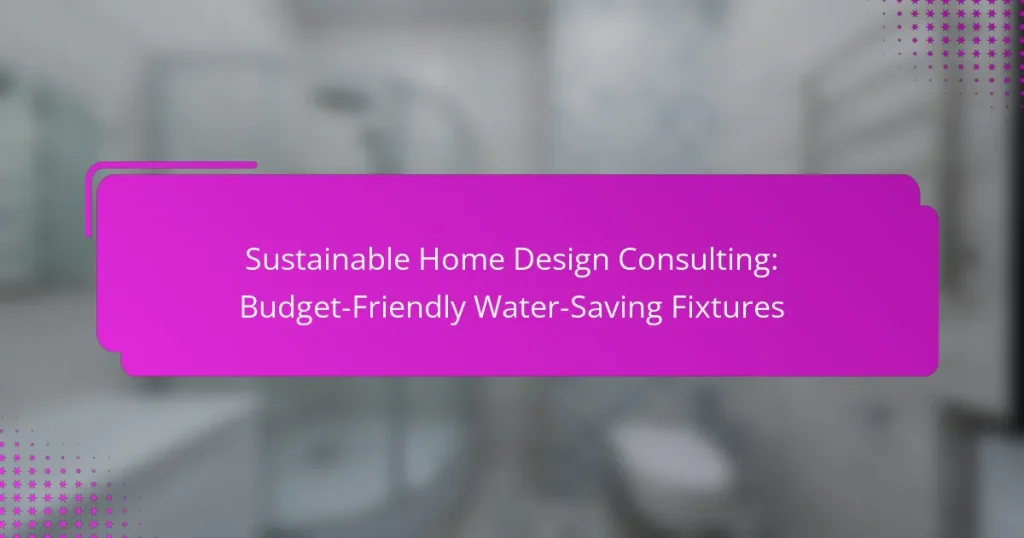Incorporating budget-friendly water-saving fixtures into your home design is a vital step toward sustainability and efficiency. These fixtures not only help reduce water consumption and lower utility bills but also play a significant role in environmental conservation. By carefully selecting the right fixtures, you can enhance your home’s functionality while making a positive impact on both your finances and the planet.
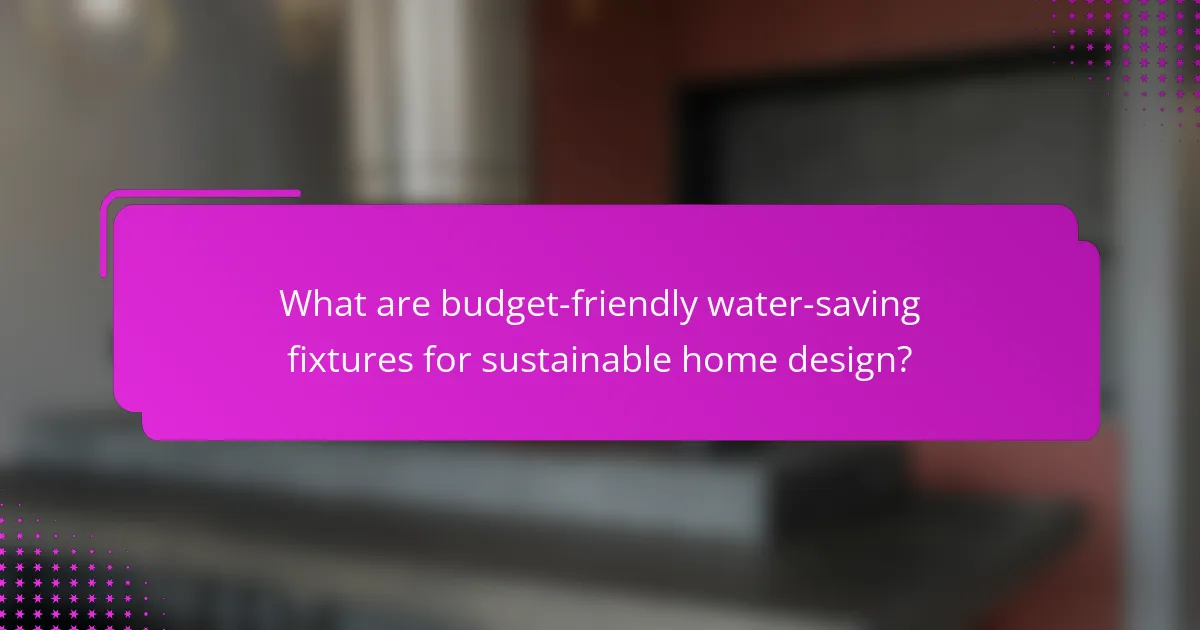
What are budget-friendly water-saving fixtures for sustainable home design?
Budget-friendly water-saving fixtures are essential components of sustainable home design that help reduce water consumption while maintaining functionality. These fixtures not only lower utility bills but also contribute to environmental conservation by minimizing water waste.
Low-flow showerheads
Low-flow showerheads are designed to use significantly less water than traditional models, typically reducing flow to around 1.5 to 2.0 gallons per minute (GPM). This can lead to substantial water savings without sacrificing shower quality.
When selecting a low-flow showerhead, look for models that meet the WaterSense label, which ensures they meet efficiency standards. Installation is usually straightforward, making it a practical upgrade for any bathroom.
Dual-flush toilets
Dual-flush toilets offer two flushing options: a lower volume for liquid waste and a higher volume for solid waste, typically using 1.1 gallons per flush (GPF) for the former and 1.6 GPF for the latter. This design can reduce water usage by up to 30% compared to standard toilets.
Consider models that are certified by the Environmental Protection Agency (EPA) for optimal performance and efficiency. Proper installation is crucial to ensure the toilet functions correctly and efficiently.
Water-efficient faucets
Water-efficient faucets are designed to limit flow rates to 1.5 GPM or less, helping to conserve water in kitchens and bathrooms. These fixtures often feature aerators that mix air with water, maintaining pressure while reducing overall consumption.
When upgrading, choose faucets with the WaterSense label for guaranteed efficiency. Simple installation and a variety of styles make these faucets a versatile choice for any home.
Rainwater harvesting systems
Rainwater harvesting systems collect and store rainwater for non-potable uses, such as irrigation or toilet flushing. These systems can significantly reduce reliance on municipal water sources, especially in areas with adequate rainfall.
Consider local regulations regarding rainwater collection, as some regions have specific guidelines. A basic system can include gutters, downspouts, and a storage tank, making it a feasible DIY project for many homeowners.
Greywater recycling systems
Greywater recycling systems reuse water from sinks, showers, and washing machines for irrigation or toilet flushing. This practice can save a substantial amount of water, especially in homes with high water usage.
Before installation, check local codes and regulations, as greywater systems may require permits or specific standards. A basic system can be installed with minimal plumbing changes, making it an accessible option for eco-conscious homeowners.
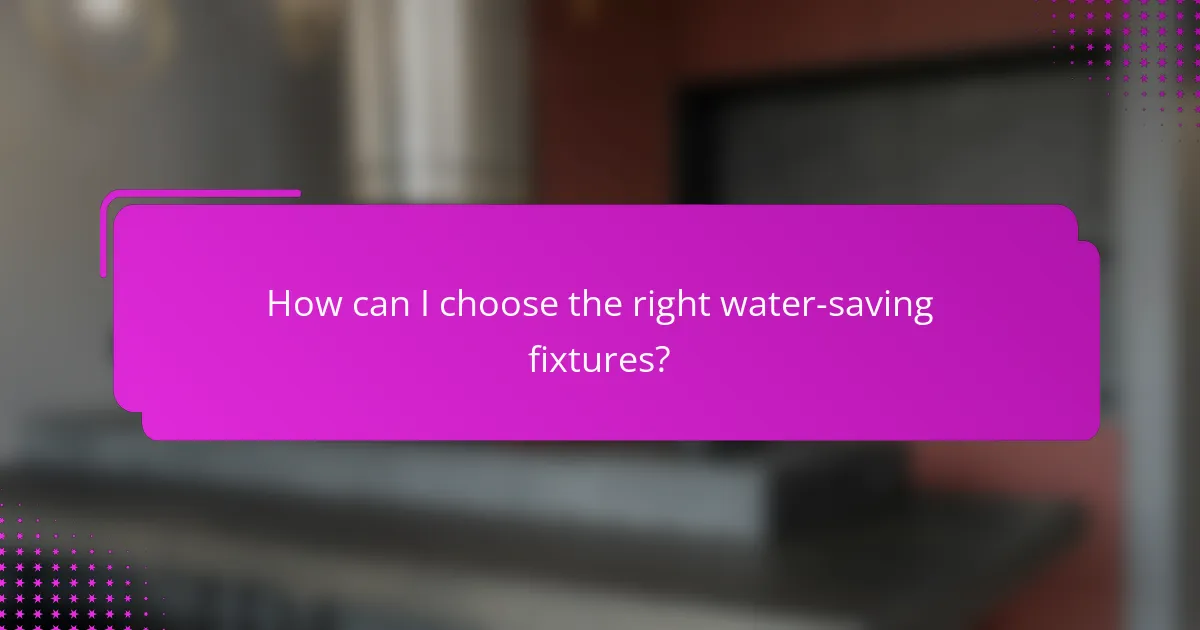
How can I choose the right water-saving fixtures?
Choosing the right water-saving fixtures involves understanding your household’s water usage, ensuring compatibility with existing plumbing, and evaluating installation costs. By focusing on these key areas, you can make informed decisions that enhance efficiency while staying within budget.
Assess household water usage
Start by reviewing your current water consumption to identify where savings can be made. Track your water bill over several months to determine average usage, and consider using a water meter to get precise readings. This data will help you decide which fixtures can significantly reduce water usage.
Common areas to target include toilets, faucets, and showerheads, as these typically account for a large portion of household water consumption. For instance, replacing an old toilet with a low-flow model can save several thousand liters annually.
Consider fixture compatibility
Before purchasing new water-saving fixtures, check their compatibility with your existing plumbing and layout. Some fixtures may require specific fittings or adjustments, which could lead to additional costs. Measure the space available for installation to ensure a proper fit.
It’s also wise to consider the water pressure in your home. Some low-flow fixtures perform best under certain pressure conditions, so verify that your plumbing can support the new installations without compromising performance.
Evaluate installation costs
Installation costs can vary widely based on the type of fixture and the complexity of the installation process. Simple replacements, like showerheads or faucet aerators, can often be done as a DIY project, saving on labor costs. However, more complex installations, such as new toilets or whole-house systems, may require professional help.
Get multiple quotes from licensed plumbers to compare installation costs. Additionally, factor in any potential savings on your water bill when considering the overall investment in water-saving fixtures. Look for fixtures that meet local efficiency standards, as these may qualify for rebates or incentives, further reducing your expenses.
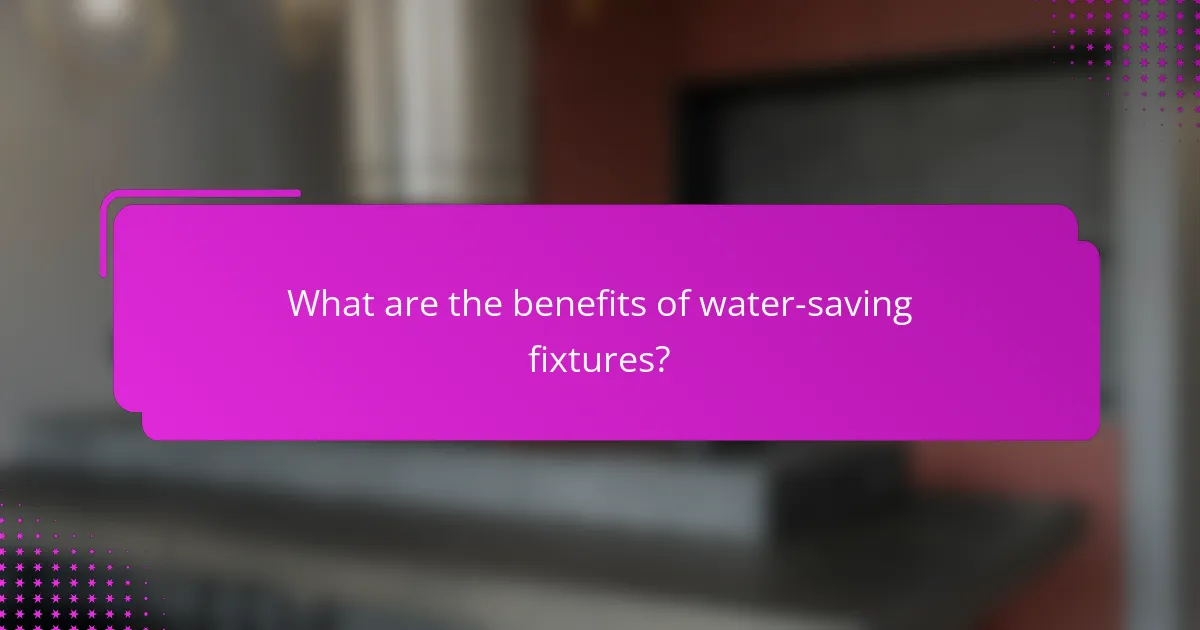
What are the benefits of water-saving fixtures?
Water-saving fixtures offer numerous advantages, including reduced utility costs, a positive environmental impact, and potential increases in property value. By using less water, these fixtures contribute to sustainability while also saving homeowners money.
Reduced water bills
One of the most immediate benefits of installing water-saving fixtures is the reduction in water bills. These fixtures can cut water usage by 20-50%, depending on the type and efficiency of the product. For example, a low-flow showerhead can use as little as 1.5 gallons per minute compared to standard models that may use over 2.5 gallons.
Homeowners can expect to see noticeable savings on their monthly water bills, especially in areas where water costs are higher. Regularly checking for leaks and ensuring fixtures are properly installed can further enhance savings.
Environmental impact
Water-saving fixtures significantly reduce water consumption, which helps conserve this precious resource. By using less water, these fixtures contribute to lower demand on local water supplies and reduce the energy required for water heating and treatment. This can lead to a smaller carbon footprint for households.
Additionally, many regions face water scarcity issues, making conservation efforts vital. Installing efficient fixtures is a practical step individuals can take to support environmental sustainability and protect local ecosystems.
Increased property value
Homes equipped with water-saving fixtures may see an increase in property value, as energy-efficient and sustainable features are increasingly attractive to buyers. Many prospective homeowners prioritize eco-friendly options, making these fixtures a selling point during real estate transactions.
Furthermore, properties that demonstrate lower utility costs can appeal to budget-conscious buyers. Investing in water-saving fixtures can thus enhance marketability and potentially lead to a quicker sale at a favorable price.
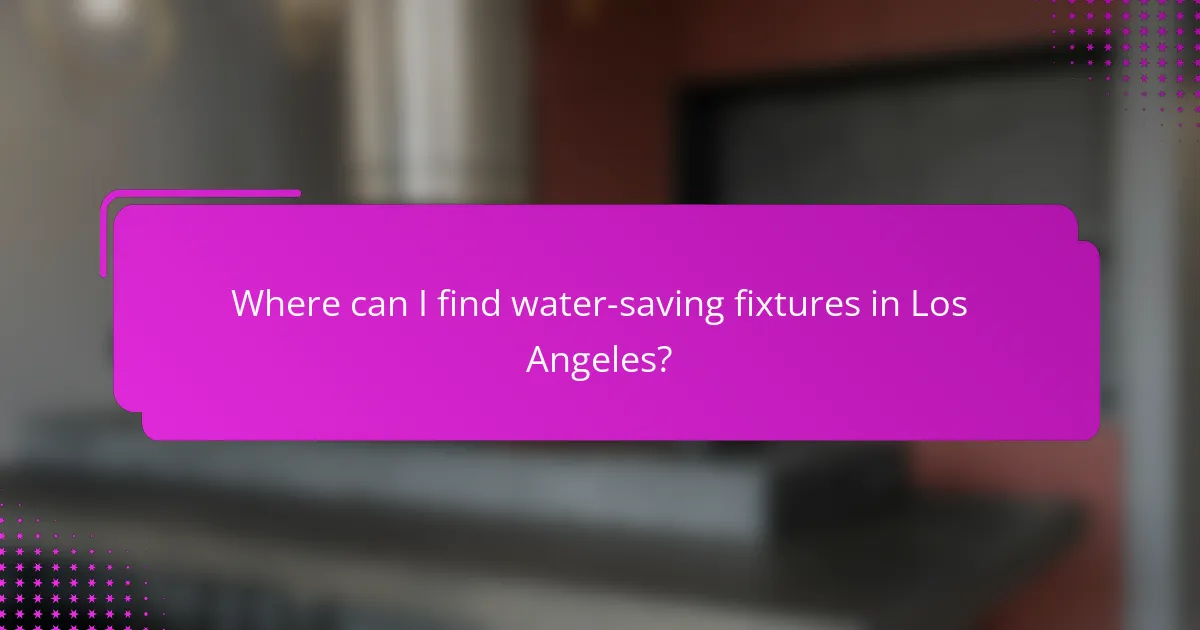
Where can I find water-saving fixtures in Los Angeles?
In Los Angeles, you can find a variety of water-saving fixtures at local home improvement stores, online retailers, and specialty eco-friendly suppliers. These options cater to different budgets and preferences, making it easier to incorporate sustainable solutions into your home design.
Local home improvement stores
Major home improvement stores in Los Angeles, such as Home Depot and Lowe’s, offer a wide selection of water-saving fixtures. These stores typically stock low-flow faucets, showerheads, and dual-flush toilets that meet California’s water efficiency standards.
When shopping at these stores, look for products labeled with the WaterSense label, which indicates they meet specific water-saving criteria. Visiting the store allows you to see the fixtures in person and ask staff for recommendations.
Online retailers like Amazon
Online platforms like Amazon provide a convenient way to browse and purchase water-saving fixtures from the comfort of your home. You can find a vast range of products, including smart irrigation systems and water-efficient appliances.
Be sure to read customer reviews and check for certifications like WaterSense when selecting fixtures online. This helps ensure you are choosing high-quality products that will effectively reduce water usage.
Specialty eco-friendly suppliers
Specialty eco-friendly suppliers in Los Angeles, such as EcoHome and Green Building Supply, focus on sustainable products, including water-saving fixtures. These suppliers often carry unique and innovative options that may not be available in larger retail chains.
Shopping at these stores can provide additional benefits, such as expert advice on sustainable home design and access to rebates or incentives for water-efficient upgrades. Consider visiting these suppliers to explore eco-friendly choices that align with your sustainability goals.
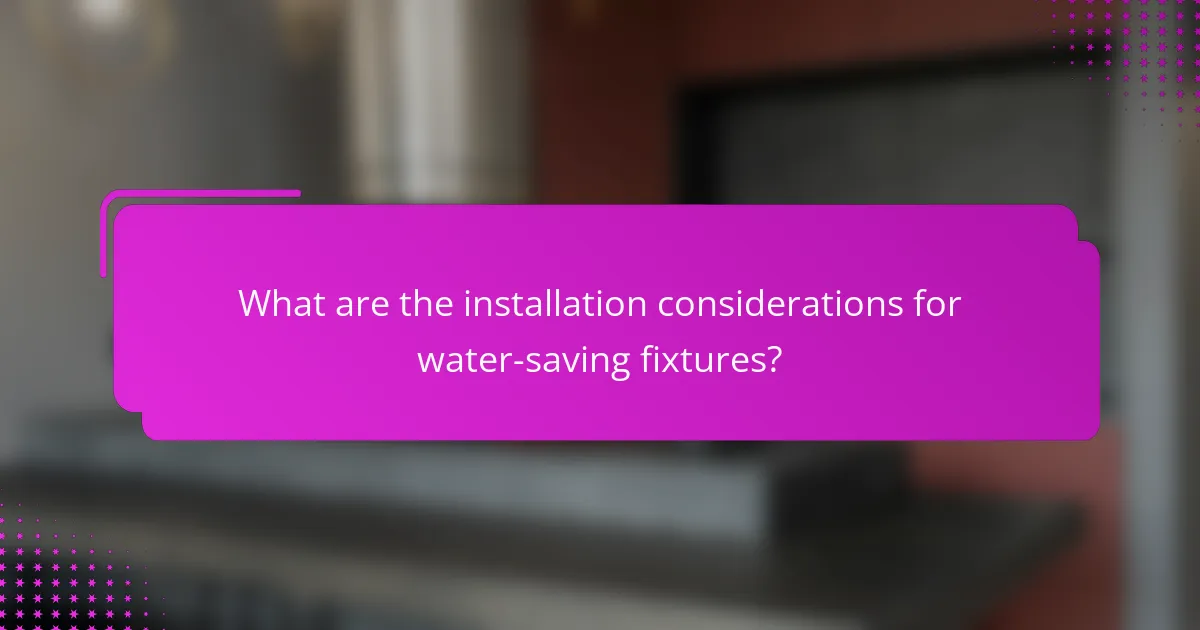
What are the installation considerations for water-saving fixtures?
When installing water-saving fixtures, consider factors such as compatibility with existing plumbing, local regulations, and the potential need for professional assistance. Proper installation ensures optimal performance and maximizes water conservation benefits.
Professional vs DIY installation
Choosing between professional and DIY installation depends on your plumbing skills and the complexity of the fixtures. Simple fixtures like low-flow showerheads can often be installed by homeowners, while more complex systems, such as dual-flush toilets, may require a professional to ensure proper function and compliance with local codes.
Hiring a plumber typically costs between $50 to $150 per hour, but it can save time and prevent costly mistakes. If opting for DIY, ensure you have the right tools and follow manufacturer instructions closely.
Permitting requirements in California
In California, certain water-saving fixture installations may require permits, especially for major plumbing changes. Check with your local building department to determine if your project needs a permit, as this can vary by city.
Common fixtures that may require permits include new toilets or significant alterations to existing plumbing systems. Failing to obtain necessary permits can result in fines or complications when selling your home.
Maintenance tips for longevity
To ensure the longevity of water-saving fixtures, regular maintenance is essential. Clean aerators and showerheads periodically to prevent mineral buildup, which can reduce water flow and efficiency.
Inspect seals and connections for leaks, as even small leaks can waste significant water over time. Consider replacing washers and gaskets every few years to maintain optimal performance.
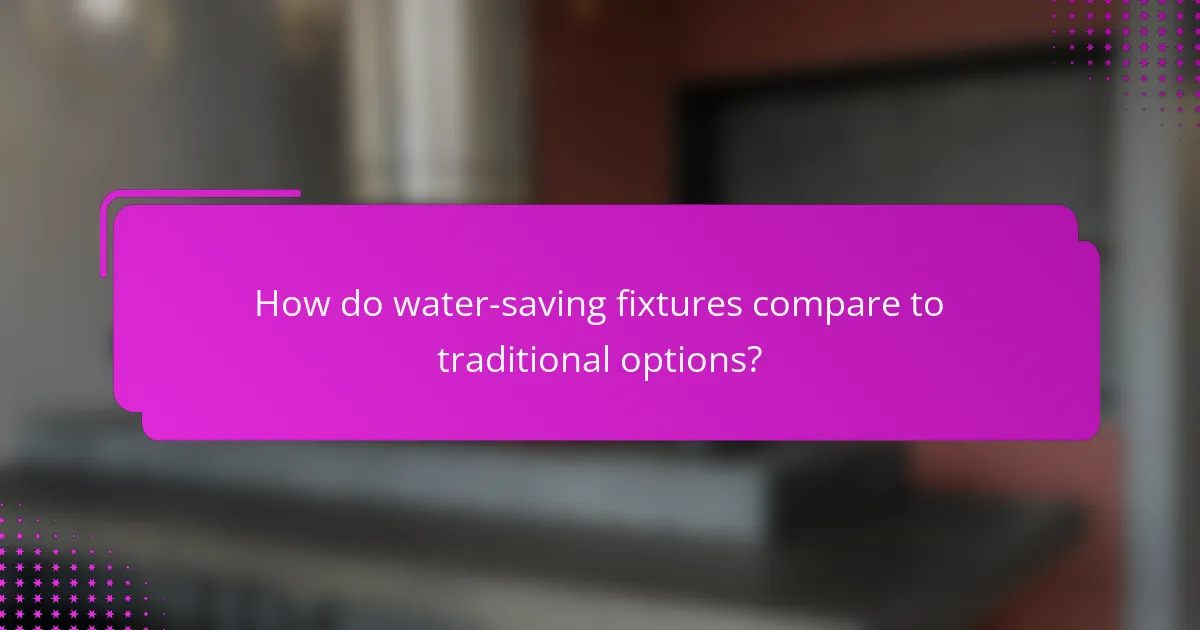
How do water-saving fixtures compare to traditional options?
Water-saving fixtures are designed to use significantly less water than traditional plumbing options, often reducing consumption by 20-60%. These fixtures, such as low-flow toilets and aerated faucets, not only conserve water but can also lower utility bills over time.
Water usage statistics
In the average household, water usage can vary widely, but approximately 30% of indoor water consumption is attributed to toilets, while faucets account for about 15%. By switching to water-saving fixtures, households can reduce their overall water usage by tens of thousands of liters annually.
For example, a standard toilet uses around 13 liters per flush, whereas a low-flow model typically uses only 4.5 liters. This difference can lead to substantial savings on water bills, especially in regions where water costs are high.
Additionally, many municipalities offer rebates or incentives for installing water-efficient fixtures, making them a financially savvy choice. Homeowners should check local regulations and programs to maximize savings while contributing to water conservation efforts.
